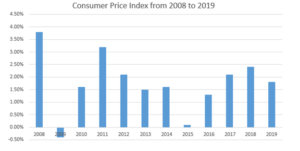How can it be in recent years that gas prices exceeded $4 per gallon and food prices rose, yet inflation, as measured by Consumer Price Index hovered around the 2 to 3 percent range? Does there seem to be a disconnect to you?
If your answer is “yes,” you are not alone. Despite repeated reassurances by the Federal Reserve Bank that inflation was well in hand, a growing number of notable economists have been questioning how accurately the CPI actually tracks the true rise in the very same consumer goods and services that we use every day.
To fully appreciate the controversy, it may be valuable to step back and take this in context. The Bureau of Labor Statistics of the U.S. Department of Labor is charged with tracking changes in the prices of 207 consumption items such as raw materials and goods and services at the manufacturer, wholesale, and retail levels in 44 geographical areas. The result is 9,108 components, which, at times, behave similarly and, at other times, differently. The technical issues imposed are daunting to say the least. While the methodology used for this tracking can be critical, it is inevitably the local retail price level that most affects consumers at the grocery store, gas pump and restaurant.
The official annual 1998-2019 CPI is depicted in the following chart. You may recall when the economy was coming off the 2008-2009 financial crisis, the big concern was actually “deflation.” That occurs when prices decline and is perhaps the scariest of all scenarios. Deflation was a dominant factor in extending the Great Depression of the 1930s. When consumers believe that prices are falling, they are less likely to spend money and do the activities they normally do. The economic results can be disastrous.
So during much of the economic recovery, the Federal Reserve has been working in earnest to actually create modest inflation. And they have claimed reasonable success in those efforts, which seemed to be supported by, among other things, the chart below.

 *Consumer Price Index (CPI-U) data is provided by the US Department of Labor Bureau of Labor Statistics. The above CPI data was last updated by the government agency January 2019 and covers up to December 2018. Source “Consumer Price Index,” Bureau of Labor Statistics. https://www.bls.gov/cpi/#tables.
*Consumer Price Index (CPI-U) data is provided by the US Department of Labor Bureau of Labor Statistics. The above CPI data was last updated by the government agency January 2019 and covers up to December 2018. Source “Consumer Price Index,” Bureau of Labor Statistics. https://www.bls.gov/cpi/#tables.
But a growing number of leading economists and academics are questioning the accuracy of the government’s CPI to track the true costs of goods and services on which we spend money on every day to live, work and entertain ourselves. One noted economist, John Williams, has gone so far as to routinely refer to the CPI as a “bogus index.” The Dartmouth-trained economist believes that the Bureau of Labor Statistics has, under the auspices of “improvement,” actually changed the calculation method “24 times since 1978” and that if the same methodology were being used today, the true CPI figures could be closer to 10 percent!
One methodology change in particular, called “the substitution effect,” was recommended by the Boskin Commission Report under the Bush I and Clinton administrations in the 1990’s. It is often cited as an overt example of CPI understatement. Underlying this process is the presumption that when prices for goods and services rise, consumers will tend to “substitute like products to avoid the price increases.” An example is when the price of steak rises, it is assumed that even the most devoted consumer will choose to buy hamburger instead. Whether that behavioral change actually occurs, and to what extent, is the subject of great controversy. Critics claim that this one change in and of itself could be understating the true inflationary pattern by 1-2 percent annually. The argument continues that when you factor in all the other methodology changes, some minor and others major, the end result is a dramatically understated CPI.
What possible incentive would there be to understate such a critical economic indicator? Because the CPI is the key inflation index used to adjust social security, military retirement, and numerous other entitlement programs. It is also the basis for our income tax system, including tax brackets, personal exemptions, and the standard deduction. Bottom line, the Boskin Commission estimated that over $600 billion would be saved if CPI increases were be reduced by 1.1 percent annually for the ten year period 1997-2006. Follow-up studies have verified a continuing boas of at least 1.0 percent per year, if not greater.
Conspiracy theories aside, “product downsizing” may be another way that inflation is subtly affecting us. When this happens, packaging of items, particularly in the food category, contain less product as before, but priced the same as before.
The New York Times suggested an idea called “stealth inflation” where commodity costs rise in the face of an otherwise tight-fisted economy where frugal shoppers abound. Rather than pass prices on and risk losing market share to a cheaper competitor, the slightly smaller package allows manufacturers to pass on rising prices in a discrete manner less likely to incur customer wrath. So for example, when a 2- ounce candy bar suddenly appears on the shelves one day as 1.8 ounces but continues to sell for the same price, the change could be construed as an 11 percent price increase.
As John Gourville, Harvard Business School marketing professor, so aptly put it, “Consumers are generally more sensitive to changes in prices than to changes in quantity.” So Gourville suggests that subtle changes in package design or inclusion of more air to fill the package can give the same shelf appearance. But the reality is that less in hand for the same price equals higher cost. And that spells inflation in any language.
How these practices specifically affect us may be the fuel for much economic controversy. When translated into our future planning, at the very least it can serve to place more emphasis on the need for growth in savings among investors of all ages.
Over one in four of us may be facing 30 years or more of retirement (according to the Society of Actuaries Annuity 2014 Mortality Table). Should inflation average 5 percent per year, it will take $141 in just 7 years to buy what $100 buys today. Since the number one fear of retirees today is running out of money, achieving financial independence in our golden years is vital. Therefore, it is absolutely imperative that techniques geared toward capital and purchasing power preservation be an essential part of every retirement portfolio.
Uncertainty over the economy and financial markets has many people concerned about their financial futures. For friends, relatives and colleagues who may find this information helpful, please feel free to share with them. Remember, for those who could benefit we offer a complimentary, no obligation “Second Opinion” that can offer an objective financial review. Keep us in mind for those who may be seeking a wealth management practice like ours—one that delivers services according to the needs and perspectives of its clients.
This information is not considered a recommendation to buy or sell any investment or insurance. We strongly recommend an advanced tax and estate planning expert be contacted for further information. Any opinions are those of Mitchell Kauffman and not necessarily those of Wells Fargo Advisors Financial Network (WFAFN). The information has been obtained from sources considered to be reliable, but WFAFN does not guarantee that the foregoing material is accurate or complete.
This material is being provided for information purposes only and is not a complete description, nor is it a recommendation. Wells Fargo Advisors Financial Network LLC (WFAFN) does not provide tax or legal advice. We strongly recommend an advanced tax and estate planning expert be contacted for further information. Any opinions are those of Mitchell Kauffman and not necessarily those of WFAFN. The information has been obtained from sources considered to be reliable, but Wells Fargo Advisors Financial Network does not guarantee that the foregoing material is accurate or complete. Prior to making a financial decision, please consult with your financial advisor about your individual situation.
Mitchell Kauffman provides wealth management services to corporate executives, business owners, professionals, independent women, and the affluent. He is one of only five financial advisors from across the U.S. named to Research magazine’s prestigious Advisor Hall of Fame in 2010, and among a select list of 100 over the past 20 years.
Inductees into the Advisor Hall of Fame have passed a rigorous screening, served a minimum of 15 years in the industry, acquired substantial assets under management, demonstrate superior client service, and have earned recognition from their peers and the broader community.
Kauffman’s articles have appeared in national publications, and he is often quoted in the media. He is an Instructor of Financial Planning and Investment Management at the University of California at Santa Barbara.
For more information, visit www.kwmwealthadvisory.com or call (866) 467-8981. Investment products and services are offered through Wells Fargo Advisors Financial Network LLC (WFAFN), Member SIPC. KWM Wealth Advisory is a separate entity from WFAFN.


